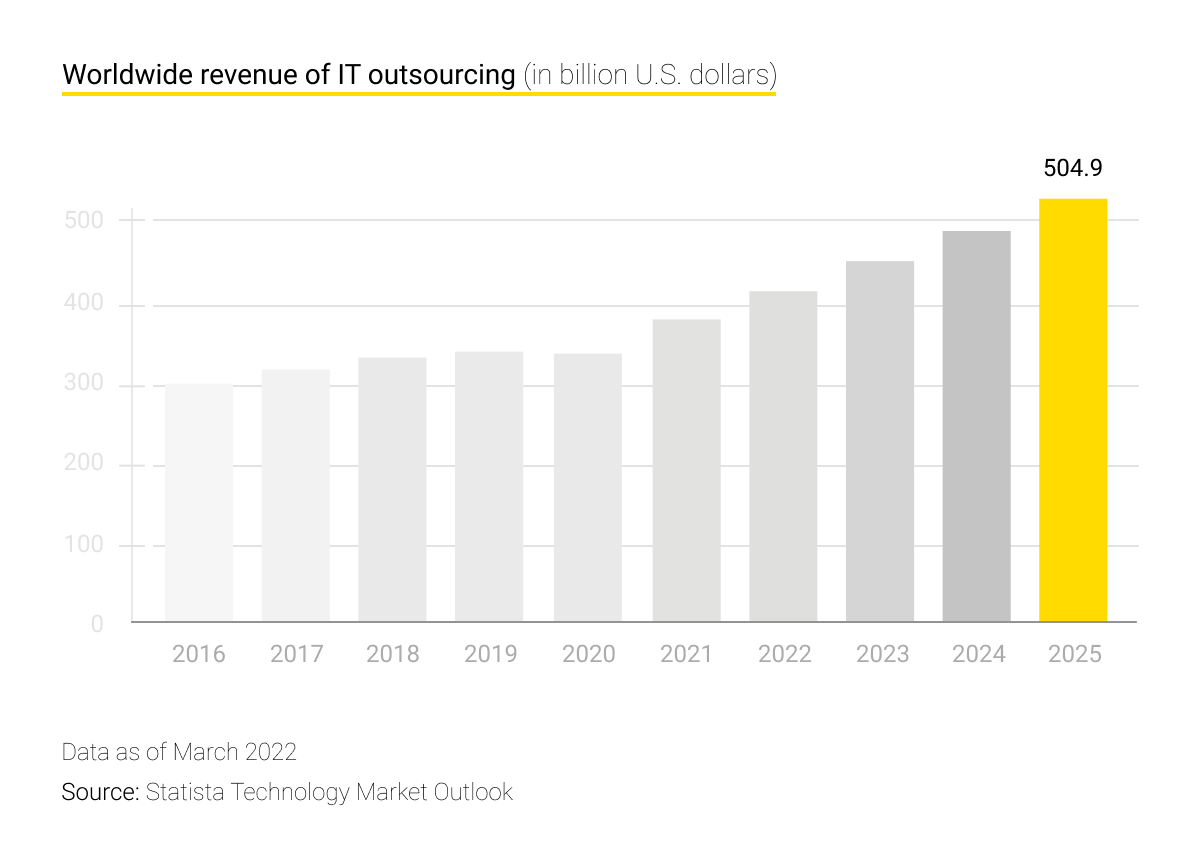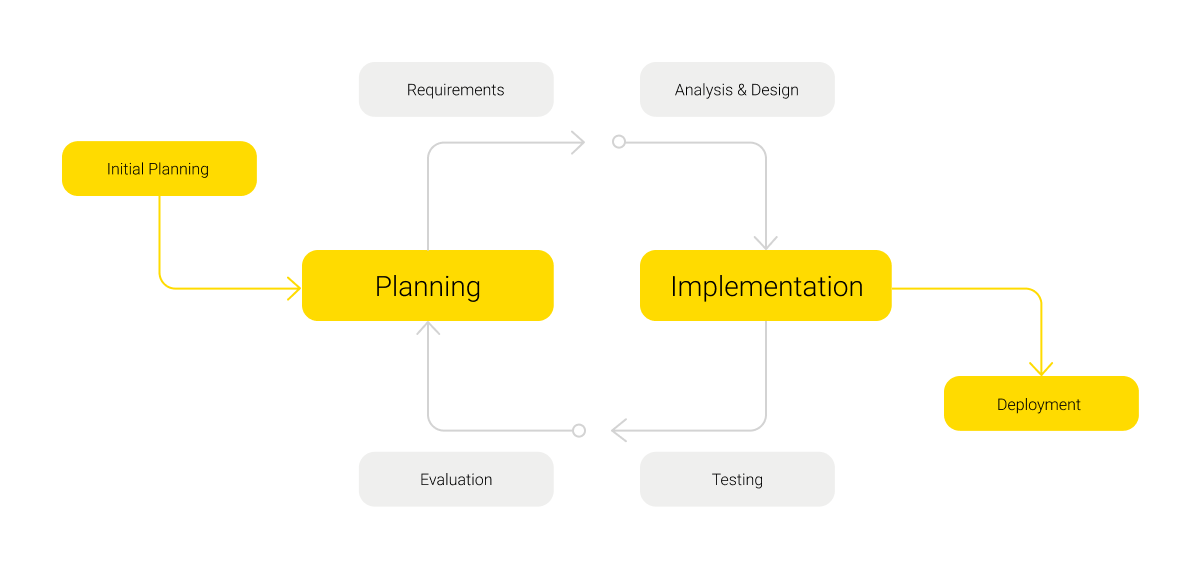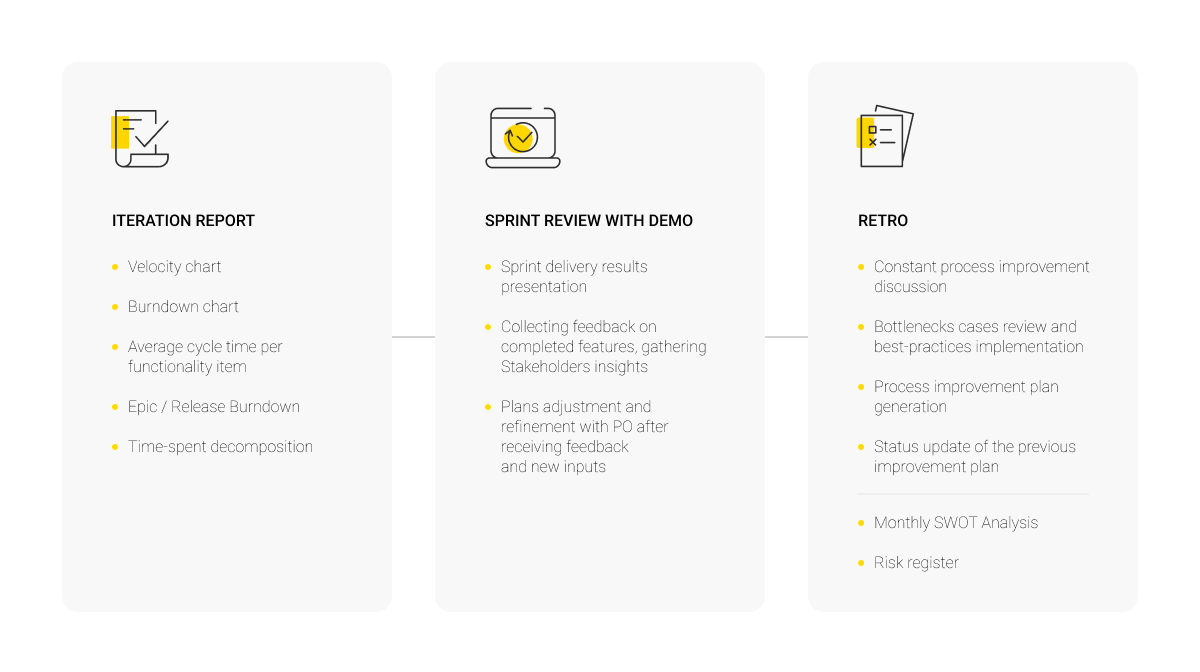- When do you need to hire an external company?
- The benefits of partnering with a third-party company
- The most frequent fears about collaborating with a third-party company
- How to avoid risks when outsourcing?
- Choose the engagement model that suits your needs
- Calculate the project cost and timelines
- Turn to Agile methodology
- Seek effective team collaboration based on Scrum
- To wrap up
Sooner or later, every fast-scaling company that wants to keep pace with rapidly evolving digital technology needs to implement an IT project without delay. This is when outsourcing comes to the rescue. The last several years with their increasing trend for remote work and economic turmoil have changed employers’ attitudes towards in-house hiring. Today, companies tend to entrust their projects to external vendors. However, while benefiting from cost-effectiveness and access to vast technical expertise, businesses might lose control over the work process. Read on to learn how to avoid pitfalls while collaborating with an IT company and make sure that your dedicated software development team is truly performing.
When do you need to hire an external company?
The rapid advancement of technologies has sparked an IT outsourcing market growth of 13% in 2020-2021, and its revenue is projected to exceed $500 billion by 2025.

When does your business need a hand from an external party? Let’s consider each case in detail:
-
You’re looking for an expeditious time to market. Recruiting in-house specialists and bringing them up-to-date requires time, especially if your company doesn’t specialize in technologies. An already assembled team will start delivering within days of agreeing on the terms, and thus, you will get a working product and profit from it faster.
-
Your project needs extensive expertise. Building industry-specific software might require technical knowledge and business expertise. A professional IT company will provide you with niche experts who are otherwise hard to find.
-
You desire to meet critical business needs in a timely manner. When the scope of work is enhanced or unexpected issues arise, entailing the need for more specialists, your team will be promptly strengthened with the needed experts.
-
You require additional resources for scaling up or upgrading your existing solution. When turning to a dedicated software development team, you get access to top-notch experts who have mastered the required technology stack and will in no time upgrade your business-critical systems and scale them in a seamless and efficient fashion.
The benefits of partnering with a third-party company
Turning to an external company has lots of benefits. Below are just some of them:
Vast technical expertise
Professional companies employ high level experts, including Project Managers, Business Analysts, UI/UX designers, developers with knowledge in the most demanded programming languages, QA engineers for manual and automated testing, and more. Thus, your vendor will provide you with certified specialists with a proven track record. Moreover, such companies follow the latest technological trends and consult with their customers on how to effectively apply them to their businesses.
Well-established processes
An experienced vendor has worked on hundreds of projects before and has well-oiled work processes. They know exactly where issues might arise, how to provide precise time and cost estimations, what documents need to be drawn up, and how to ensure effective communication within the Agile development team and with stakeholders using Jira, Confluence, and other tools. Moreover, both parties sign a service level agreement stipulating the scope of work, performance metrics, timelines, payment schedule, penalties, and other details. Thus, you can be certain of transparent and streamlined cooperation.
Cost reduction
According to Deloitte’s survey, cost reduction is the main reason why companies enter into a contract with external vendors. Offshoring means you can choose the best talents from Ukraine, Poland, etc., allowing you to save on recruitment, equipment, and taxes and thus, benefit from high-quality deliverables at low rates.
Time saving
Sharing control over work processes with an Agile Project Manager or a Scrum Master allows you to reap benefits from streamlined communication with the team and well-oiled operations. As you no longer need to closely monitor the team’s performance and be fully informed of all technical peculiarities, you can devote your time to outlining a business strategy, negotiating with investors, conducting market research, promoting your brand, improving customer service, and performing other crucial business activities.
Immediate scaling and strengthening of teams
There are situations when you need to strengthen your team with a skilled designer, developer, Project Manager, or other specialists as soon as possible. Your IT partner will promptly strengthen the team with as many skilled and qualified specialists as needed to avoid work delays without compromising quality.
Focus on delivering value
In the course of work, you might want to modify the product, for example, to add new features to it or integrate it with other systems. A company that adheres to Agile methodology delivers pieces of working functionality after each iteration and thus, can discuss the emerging changes with the customer.
The most frequent fears about collaborating with a third-party company
In spite of all the advantages, working with an external provider might appear intimidating. Below are the concerns customers have most frequently, which are, however, adroitly managed by experienced vendors:
Concerns related to the possible lack of control over the work
When considering hiring an offshore team, customers are often concerned about losing control over the course of work. They doubt whether entrusting their pet projects to random service providers is reliable as there is a risk that the latter won’t manage the work efficiently. On top of that, customers might be troubled by not being able to properly monitor their team’s performance and thus, ensure that they put heart into their work. Finally, business owners might have a fear that their contractors won’t be able to keep pace with the fast-evolving technology, failing to adapt to the latest trends.
Fortunately, experienced teams with a well-established management process have performance tracking tools in place and regularly update the customer on the work progress providing them with detailed reports. In addition, when customers hire a dedicated development team, the product ownership and strategic management is still under their control; they are involved in decision-making and have all the necessary information about the process.
Concerns regarding inadequate data protection
When working with an external company, you disclose information that might include your employees’ personal data, proprietary information, and so on. Therefore, you can be rightly concerned about data leakage.
This risk is minimal as at the initial stage of their cooperation both parties sign a non-disclosure agreement stipulating their responsibility when handling the sensitive information. On top of that, Andersen ensures the security of our customers’ data by complying with world-recognized standards and laws, such as GDPR, ISO/IEC 27001, and more, while our experts have prestigious certifications in the field of information security, e.g. SSCP, OSCP, OSWE, etc.
Concerns related to communication issues
When considering working with offshore companies, customers might doubt that they will be able to contact the teams whenever needed due to time zone differences. Additional communication issues might be caused by language and cultural discrepancies.
These challenges, however, are successfully overcome by the efforts of skilled Project Managers and Scrum Masters. These experts plan the team’s schedule, monitor their engagement and ensure that they remain highly motivated, mitigate cultural discrepancies, and organize work in accordance with the principles of mutual respect and effective teamwork thanks to the implementation of Agile principles.
Concerns regarding insufficient product quality
You might be rightly considering the risk of encountering an irresponsible firm that will deliver you a poor-quality product. To minimize this, find out as many insights as possible about your prospective IT partner by reading reviews on market research platforms, e.g. Clutch and GoodFirms, and having an online meeting with their managers to learn more about their processes. On top of that, Andersen’s teams deliver working functionality to our customers after every Sprint. This ensures that your feedback and requirements will be taken into consideration, contributing to the continuous improvement of product quality.
How to avoid risks when outsourcing?
When you decide to enter into a contract with an external company, you want to be sure that your team is performing efficiently. Based on Andersen’s experience, we recommend that our readers should consider the following points.
Choose the engagement model that suits your needs
The most popular cooperation models are staff augmentation, a team-based approach, and a project-based approach. Based on our experience, we recommend our customers consider hiring a dedicated development team.
This cooperation model resembles car rental. Having a car selected in accordance with your needs and the destination you want to reach is of paramount importance. Top-notch specialists in their sphere, i.e. a car rental company, choose a car with the optimal parameters. They also deal with having it serviced and solving issues with its insurance so you don’t have to.
This engagement model, unlike when simply augmenting your staff with developers, allows you to delegate control over the processes and micromanagement issues to your contractor. Being released from the burden of solving management issues, you, at the same time, remain involved in decision-making, sharing the responsibility for the project’s risks and successes with the IT partner. Thus, you benefit from completely clear processes, taking part in high-level management, while an Agile Project Manager or a Scrum Master manage tasks and supervise operations.
The above approach works best when applied to mid-term and long-term projects with vague requirements and with an in-house Product Owner having domain expertise.
Calculate the project cost and timelines
You may wonder how to proceed after you have agreed on hiring an external company, chosen the right cooperation model, and set to work. The main questions every customer is concerned about at this stage are “How long will the project take?” and “How much will it cost?”
These are answered during the initiation phase when a business scenario is drawn up, including the development outcomes and success criteria. Andersen’s experts recommend including these insights into a roadmap outlining who will work on your product, what needs to be done, and when it will be done.
At Andersen, we outline the development cost and timelines and inform the customer of possible risks during the Discovery phase. Our experienced Business Analysts also agree with the customer on the features of a minimal viable product.
As a result, the customer considers the profitability and feasibility of the solutions proposed by the company and decides whether to proceed based on preliminary estimations.
Turn to Agile methodology
When you agree on the scope of work, its cost, and timelines, the company starts working on your product. Today, the majority of projects are implemented according to Agile methodology. This approach necessitates developing in iterations, i.e. periods of time lasting from two to four weeks. At the end of each iteration, an increment is added to the working version of a product. An increment is a tangible result of work, e.g. a new feature embedded in the website or a mobile app prototype. Working in iterations allows the Agile development team to promptly receive feedback from the customer and plan further iterations to improve the product. The use of Agile methodology provides for increased flexibility and adaptivity to changes even at the latter stages of work. It ensures transparency of processes as all project participants can easily check the status of tasks. In addition, its undeniable benefit is the high level of engagement of the customer in the work process as they perform product ownership and management functions. Therefore, the customer has control over the processes and makes decisions based on the insights provided by the team.
Seek effective team collaboration based on Scrum
The importance of ensuring effective team collaboration and transparency of processes can scarcely be overestimated. All this is possible thanks to the Scrum framework which helps teams to find adaptive solutions to complex problems.
When using this framework, a team works with increased productivity thanks to a clearly established goal within a Sprint, i.e. a period of time from two to four weeks with a defined scope of work and tangible outcomes. Streamlined communication within the team and with the customer is ensured. The tasks in a Sprint Backlog are defined and sequenced by a Product Owner, and a seasoned Scrum Master helps the team to achieve its goals by keeping things organized and removing impediments that can slow down the work.

Therefore, when choosing a reliable company, make sure that it has solid expertise in Agile, works according to well-established Scrum processes, and involves a skilled Scrum Master. At Andersen, we provide the following reports to our customers after each Sprint to keep them up to date:
- Iteration reports, including velocity and burndown charts, time-spent analyses, etc.;
- Sprint reviews, including the demonstration of Sprint deliverables, collecting feedback from stakeholders on the implemented product features, and discussing further adjustments to the software;
- Retrospectives, i.e. reviewing bottlenecks that arose in the course of work and drawing up a plan for further improvements.

To wrap up
When you work with a professional company, this provides the potential for your business to grow. As long as you follow the above pieces of advice, you have a high chance of finding an IT partner with a proven track record, expertise in your industry, transparent delivery processes, and the ability to promptly develop a high-quality MVP.
When opting for a team-based engagement model, you maintain control over the processes while reaping the benefits of outsourcing. If you are satisfied with the results of the work of your dedicated team of developers, you can entrust your IT partner with increased responsibility by shifting to the managed delivery model. Thus, you will free up time and resources for solving strategic tasks and growing your business.
Having fifteen years of experience, Andersen provides top-notch specialists with a mastery of modern technology stacks. All of Andersen’s high-end experts have a proven track record in the main industries, e.g. FinTech, Healthcare, Logistics, Automotive, and more, backed by internationally recognized certificates. Contact us for a consultation and we will be happy to help.







